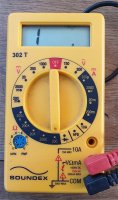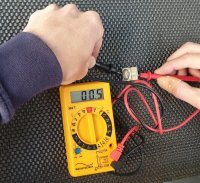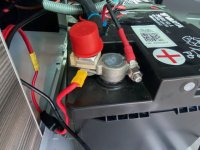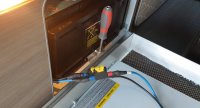ThomasHJ
Top Poster
Lifetime VIP Member
Would really appreciate some help with the following.
Our Cali is T5 2011 SE. During our recent holidays we camped without being on EHU for the first time. I noticed the batteries voltage (as shown on the central control panel) dropped quite quickly. I know the % is inaccurate and sometimes even goes back up again. But they didn’t even last 48 hours. It was hot outside, but we used nothing that draws from the batteries, other than the fridge. This surprised me as I have read here on the forums that fellow Cali owners can easily do 3 days without EHU and sometimes even 4 or 5 days. So something seems to be wrong.
Another sign that something is wrong is that the amperes that are being drawn from the batteries (as shown on the central control panel) are always at 0.0 even with the fridge and lights on. I just hadn’t noticed this before.
It’s strange, because when we bought our Cali second hand (less than a year ago) we had the VW Camper Centrum do a full check of everything. They replaced all 3 batteries (the car battery and both leisure batteries), so the batteries are all brand new.
To gather some information that might help in diagnosing the issue, I did a 'test' the last 2 days. I parked the Cali, turned on the fridge at ‘max’ (even added a normal amount of food) and checked the voltage-reading on the central control panel every few hours or so when I had the chance and wrote down the voltage reading. I kept all other things that could draw from the leisure batteries turned off (heater, lights, etc).
These are the readings:
So, within 24 hours the reading says 12.1V / 30% and after another 3 hours, so a total of 27 hours the batteries were at 12V / 20%.
At this point I figured the readings show there’s something wrong so I stopped the test. I did try one more thing and that is that I fired up the auxillary heater and the amperage draw stayed at 0.0. Which seems wrong as well.
I’m not very experienced with electrics, but spend a few nights reading through the forums. I read in this thread that there’s a possibility that the 50/75A fuse of the rear battery is blown and were just using 1 leisure battery now. It’s dark out now and I put the Cali on EHU to charge the batteries back up again. Will try to test the fuse tomorrow. Will read up on how to do that tonight, because I have only used a multimeter once before in my life.
I hope it’s something simple like that fuse, so that it can be fixed by myself. If not, I will have to bring the van in to the VW Camper centrum. But prefer to try DIY wherever possible. Also because I like to learn. I do fear that if we are on 1 battery only, this might have been the case since we bought the van. Which means one of the brand new batteries hasn’t been charged since then. Which, well, isn’t good
Any help is very much appreciated.
Our Cali is T5 2011 SE. During our recent holidays we camped without being on EHU for the first time. I noticed the batteries voltage (as shown on the central control panel) dropped quite quickly. I know the % is inaccurate and sometimes even goes back up again. But they didn’t even last 48 hours. It was hot outside, but we used nothing that draws from the batteries, other than the fridge. This surprised me as I have read here on the forums that fellow Cali owners can easily do 3 days without EHU and sometimes even 4 or 5 days. So something seems to be wrong.
Another sign that something is wrong is that the amperes that are being drawn from the batteries (as shown on the central control panel) are always at 0.0 even with the fridge and lights on. I just hadn’t noticed this before.
It’s strange, because when we bought our Cali second hand (less than a year ago) we had the VW Camper Centrum do a full check of everything. They replaced all 3 batteries (the car battery and both leisure batteries), so the batteries are all brand new.
To gather some information that might help in diagnosing the issue, I did a 'test' the last 2 days. I parked the Cali, turned on the fridge at ‘max’ (even added a normal amount of food) and checked the voltage-reading on the central control panel every few hours or so when I had the chance and wrote down the voltage reading. I kept all other things that could draw from the leisure batteries turned off (heater, lights, etc).
These are the readings:
Time | Voltage | % | |
| Wednesday | 14:42 | 12.9 | 100 |
14:45 | 12.5 | 70 | |
14:47 | 12.5 | 70 | |
19:53 | 12.5 | 70 | |
| Thursday | 8:18 | 12.3 | 50 |
10:59 | 12.2 | 40 | |
15:07 | 12.1 | 30 | |
18:11 | 12 | 20 |
So, within 24 hours the reading says 12.1V / 30% and after another 3 hours, so a total of 27 hours the batteries were at 12V / 20%.
At this point I figured the readings show there’s something wrong so I stopped the test. I did try one more thing and that is that I fired up the auxillary heater and the amperage draw stayed at 0.0. Which seems wrong as well.
I’m not very experienced with electrics, but spend a few nights reading through the forums. I read in this thread that there’s a possibility that the 50/75A fuse of the rear battery is blown and were just using 1 leisure battery now. It’s dark out now and I put the Cali on EHU to charge the batteries back up again. Will try to test the fuse tomorrow. Will read up on how to do that tonight, because I have only used a multimeter once before in my life.
I hope it’s something simple like that fuse, so that it can be fixed by myself. If not, I will have to bring the van in to the VW Camper centrum. But prefer to try DIY wherever possible. Also because I like to learn. I do fear that if we are on 1 battery only, this might have been the case since we bought the van. Which means one of the brand new batteries hasn’t been charged since then. Which, well, isn’t good
Any help is very much appreciated.







 .
.











